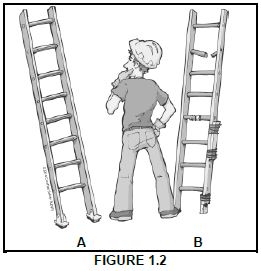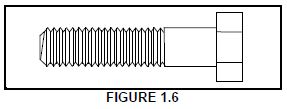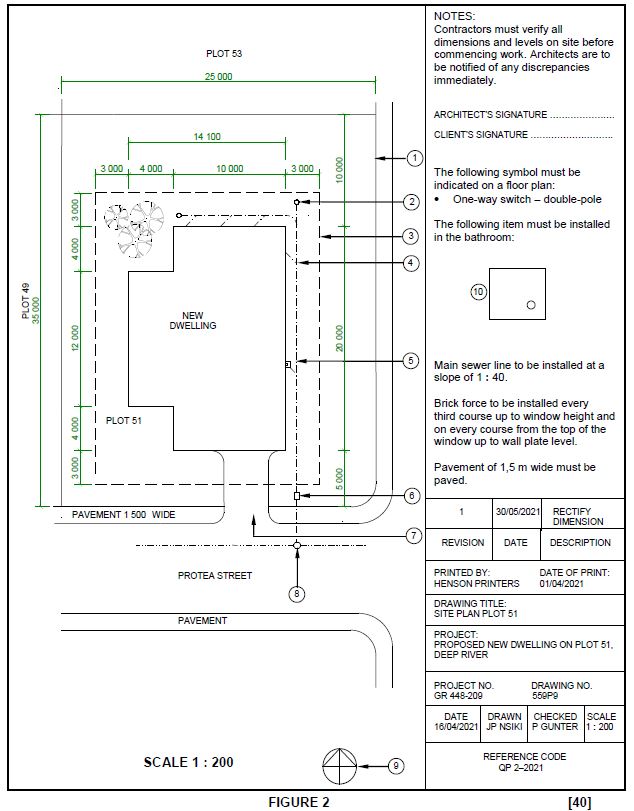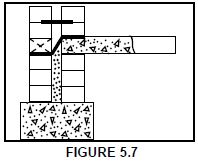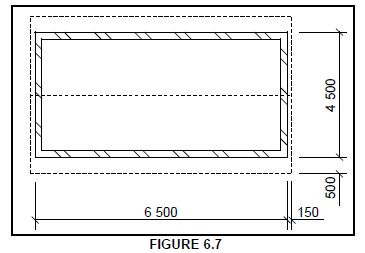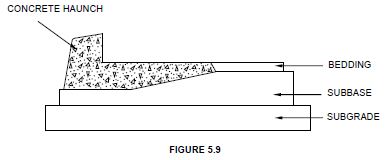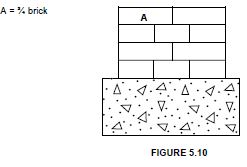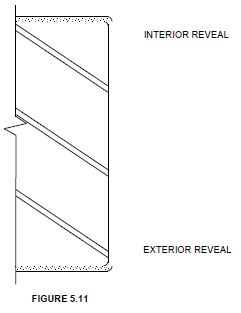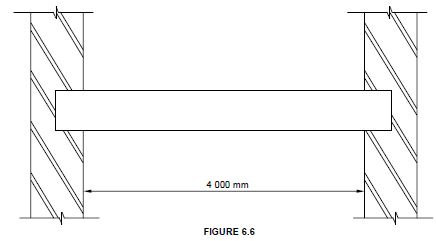CIVIL TECHNOLOGY (CONSTRUCTION) GRADE 12 QUESTIONS - NSC EXAMS PAST PAPERS AND MEMOS MAY/JUNE 2021
Share via Whatsapp Join our WhatsApp Group Join our Telegram GroupCIVIL TECHNOLOGY:CONSTRUCTION
GRADE 12
NATIONAL SENIOR CERTIFICATE EXAMINATIONS
MAY/JUNE 2021
REQUIREMENTS:
- Drawing instruments
- A non-programmable calculator
- ANSWER BOOK
INSTRUCTIONS AND INFORMATION
- This question paper consists of SIX questions.
- Answer ALL the questions.
- Read all the questions carefully.
- Answer each question as a whole. Do NOT separate subsections of questions.
- Number the answers correctly according to the numbering system used in this question paper.
- Start the answer to EACH question on a NEW page.
- Do NOT write in the margins of the ANSWER BOOK.
- You may use sketches to illustrate your answers.
- Write ALL calculations and answers in the ANSWER BOOK or on the attached ANSWER SHEETS. The SI unit for answers must be indicated next to the answer.
- Use the mark allocation as a guide to the length of your answers.
- Make drawings and sketches in pencil, fully dimensioned and neatly finished off with descriptive titles and notes to conform to the SANS/SABS Code of Practice for Building Drawings.
- For the purpose of this question paper, the size of a brick should be taken as 220 mm x 110 mm x 75 mm.
- Use your own discretion where dimensions and/or details have been omitted.
- Answer QUESTIONS 2, 3.8, 5.9, 5.10, 5.11, 6.6 and 6.7 on the attached ANSWER SHEETS using drawing instruments, where necessary.
- Write your CENTRE NUMBER and EXAMINATION NUMBER on every ANSWER SHEET and hand them in with your ANSWER BOOK, whether you have used them or not.
- Drawings in the question paper are NOT to scale due to electronic transfer.
- Google Images were used as the source of all photographs and pictures.
- Write neatly and legibly.
QUESTION 1: OHSA, SAFETY, MATERIALS, TOOLS, EQUIPMENT AND JOINING (GENERIC)
Start this question on a NEW page
1.1 Give ONE word/term for each of the following descriptions by choosing a word/term from the list below. Write only the word/term next to the question numbers (1.1.1. to 1.1.5) in the ANSWER BOOK, e.g. 1.1.6 casement
| curing; electroplating; galvanising; powder coating; paint; turpentine; sanding sealer |
1.1.1 Available in a water- or oil-based liquid (1)
1.1.2 Allows concrete to achieve its optimal strength (1)
1.1.3 Coating a metal by the process of electrolysis (1)
1.1.4 Can be melted again because no chemical process is involved (1)
1.1.5 Adds strength to the original uncoated metal (1)
1.2 FIGURE 1.2 below shows equipment that is used on a construction site.
1.2.1 State TWO materials that the equipment can be manufactured of. (2)
1.2.2 Deduce from FIGURE 1.2 the safest option to use, A or B. Motivate your answer. (2)
1.2.3 Explain the purpose of the equipment in FIGURE 1.2. (1)
1.2.4 How far from a wall should the base of a ladder be placed to ensure that it is positioned safely? (1)
1.3 A laser level is often used in construction.
1.3.1 Explain what you will determine if you use the laser level in EACH of the following cases:
- When installing a sewerage system for a building (1)
- When laying tiles against a wall (1)
1.3.2 Explain what will happen if the tripod is not wide enough when setting up the laser level. (1)
1.4 Explain what will happen if a worker manually lifts excessively heavy loads. (1)
1.5 The use of scaffolds is not permitted, unless inspected.
1.5.1 When should scaffolding be inspected? (1)
1.5.2 Who is responsible for the inspection of the scaffolding? (1)
1.6 FIGURE 1.6 below shows a joining fixture that can be used on building sites.
1.6.1 Identify the joining fixture. (1)
1.6.2 Name the part that should be used with the joining fixture. (1)
1.6.3 Explain why it is a better option to use this joining fixture to join two steel sections. (1)
[20]
QUESTION 2: GRAPHICS AS MEANS OF COMMUNICATION (GENERIC)
Start this question on a NEW page.
FIGURE 2 on the next page shows a drawing that appears on a building plan. Analyse the drawing and complete the table on ANSWER SHEET 2.
[40]
QUESTION 3: ROOFS, STAIRCASES AND JOINING (SPECIFIC)
Start this question on a NEW page.
3.1 Complete the following sentence by choosing the missing word/term regarding joining from the list given below. Write down only the word/term next to the question numbers (3.1.1 to 3.1.4) in your ANSWER BOOK, e.g. 3.1.5. screws.
| thick; strong; galvanised; nailed; one; both; roof truss; wall plate |
3.1.1 … steel straps should be taken over the top of the 3.1.2 … and 3.1.3 … down on 3.1.4 … side(s). (4)
3.2 Name TWO types of roof trusses that use a ridge beam. (2)
3.3 Write down the measurements of a ridge beam as used in roof trusses. (1)
3.4 Name ONE type of fastener that is used to join a SA Howe roof truss to a wall. (1)
3.5 State the minimum span width for an SA Howe roof truss. (1)
3.6 FIGURE 3.6 below shows a straight flight of stairs. The flight of stairs is incorrectly labelled. In your ANSWER BOOK, write down the correct label next to the number of each part, e.g. 6. pitch board.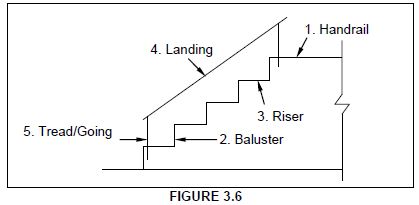
3.7 Certain principles must be considered when designing concrete stairs.
3.7.1 What should the rise of a stair be? (1)
3.7.2 What should the minimum thread be? (1)
3.7.3 What should be the maximum striking time for the sides of the steps? (1)
3.8 Use ANSWER SHEET 3.8 and draw to scale 1 : 20 just more than half of a king-post roof truss with a pitch of 30°. The span of the roof is 5 000 mm. Print labels with dimensions of any TWO parts. (13)
[30]
QUESTION 4: EXCAVATIONS, FORMWORK, TOOLS, EQUIPMENT AND MATERIALS (SPECIFIC)
Start this question on a NEW page.
4.1 Choose a description from COLUMN B that matches an item in COLUMN A. Write only the letter (A–L) next to the question numbers (4.1.1 to 4.1.8) in the ANSWER BOOK, e.g. 4.1.9 M.
| COLUMN A | COLUMN B |
| 4.1.1 High-strength concrete 4.1.2 Lead 4.1.3 Galvanised sheet metal 4.1.4 Aluminium 4.1.5 Perspex 4.1.6 Polystyrene 4.1.7 Silicone 4.1.8 Copper |
|
(8 x 1) (8)
4.2 To keep the excavations from collapsing, shuttering must be installed.
4.2.1 Name FOUR components used in shuttering that keep trenches from collapsing. (4)
4.2.2 Recommend ONE method that you will use to ensure that heavy machinery is kept at a safe distance from a trench edge. (1)
4.2.3 State TWO types of soil that requires shuttering after excavations on a building site. (2)
4.2.4 Before construction work can start, environmental engineers and land surveyors must inspect the site for anything that might delay the work. State THREE tasks that must be carried out to prepare the site after the inspection. (3)
4.2.5 State TWO aspects that will be tested under atmospheric hazards if trenches are more than 1,22 metres deep. (2)
4.2.6 Recommend ONE safety precaution that must be adhered to when working in a very deep trench to ensure quick exit out of the trench in an emergency. (1)
4.2.7 Describe why workers should be trained before working in excavations or trenches.(1)
4.3 The parts of the formwork/shuttering for fresh concrete plays an important role in the construction of formwork.
4.3.1 Name the part that supports the prop. (1)
4.3.2 Give another name for a head tree. (1)
4.3.3 Name the parts that support the vertical sides of the shuttering board. (1)
4.3.4 Explain the purpose of the wedges at the base of the formwork. (1)
4.3.5 Explain the purpose of a joist/beam at a concrete floor slab. (1)
4.4 Name ONE type of formwork that can be used for in-situ concrete on a construction site. (1)
4.5 Explain why it will be beneficial to use wedges to secure the parts of the formwork. (2)
4.6 What is the maximum pitch for the formwork of a staircase? (1) (1)
4.7 Explain what is meant by the lining of formwork. (2)
4.8 Draw a line diagram of a pair of wedges in your ANSWER BOOK. (2)
4.9 FIGURE 4.9 below shows a concrete vibrator that is used on a building site. Study FIGURE 4.9 and answer the questions that follow.
FIGURE 4.9
4.9.1 Explain the effect of continuous use of this machine for long periods on the operator. (1)
4.9.2 Describe the symptom that the operator may experience if this machine is used for a long period of time. (1)
4.9.3 Motivate why it is important to clean the parts of the concrete vibrator after use. (2)
4.10 It is important to take care of a concrete mixer. Justify why you will oil the drum of the mixer when it will be stored for a long time. (1)
[40]
QUESTION 5: PLASTER AND SCREED, BRICKWORK AND GRAPHICS AS MEANS OF COMMUNICATION (SPECIFIC)
Start this question on a NEW page.
5.1 Name the application applied to a wall surface to achieve a high quality and smooth surface. (1)
5.2 Describe the main function of water when mixing plaster. (1)
5.3 Name the mixing ratio of sand and cement that is used in plaster work for both a smooth finish and a wavy surface. (1)
5.4 Name ONE type of screed. (1)
5.5 Predict what could happen if the thickness of screed is 10 mm or less. (1)
5.6 What is the maximum size of fine aggregates used for a screed? (1)
5.7 FIGURE 5.7 below shows the bottom part of a cavity wall with a wall tie and a foundation. Study the drawing and answer the questions that follow.
5.7.1 Explain the purpose of the weep hole in a cavity wall. (1)
5.7.2 Deduce from the drawing where the weep hole must be installed. (1)
5.7.3 Differentiate, by means of line diagrams, between a butterfly-pattern wall tie and a double triangular pattern wall tie. (4)
5.8 Name ONE paving method. (1)
5.9 ANSWER SHEET 5.9 shows an incomplete drawing of paving blocks with a kerb edge. Use ANSWER SHEET 5.9 and complete the drawing. (3)
5.10 ANSWER SHEET 5.10 shows a front view of a part of a one-and-a-half brick pier built in English bond. Use the given drawing and project and draw the first TWO consecutive plan courses of the brickwork. (7)
5.11 ANSWER SHEET 5.11 shows a horizontal sectional view of a part of a one-brick wall and the labels for the exterior and interior reveals. Use ANSWER SHEET 5.11 and complete the horizontal sectional view in good proportion to illustrate how a timber door frame is built into a wall. The door opens inwards.
(7)
[30]
QUESTION 6: REINFORCEMENT IN CONCRETE, FOUNDATIONS, CONCRETE FLOORS AND QUANTITIES (SPECIFIC)
Start this question on a NEW page.
6.1 Various options are given as possible answers to the following questions. Choose the answer and write only the letter (A–D) next to the question numbers (6.1.1 to 6.1.5) in the ANSWER BOOK, e.g. 6.1.6 C.
6.1.1 A … foundation will provide a level surface for a bricklayer to lay the first brick course.
- raft
- step
- strip
- All the above-mentioned (1)
6.1.2 The raft foundation combines a … foundation around the perimeter of the floor slab to form a unit.
- step
- strip
- pad
- All the above-mentioned B(1)
6.1.3 For which type of pile foundation is a mechanical drop hammer used during installation?
- Short-bored auger piles
- Precast piles
- Steel-tube caisson piles
- All the above-mentioned (1)
6.1.4 Precast piles can be used in …
- soil where there is no movement.
- unstable soil.
- cohesive soil.
- constantly dry areas. (1)
6.1.5 For which type of pile foundation is the steel pipe slowly extracted as the concrete is poured into the pipe?
- Driven in-situ piles
- Steel tube caisson piles
- Precast concrete piles
- Short-bored piles (1)
6.2 Use your ANSWER BOOK and draw a neat freehand sketch of a drop hammer used in driven in-situ piles to form an enlarged base. (4)
6.3 Use your ANSWER BOOK and draw a neat freehand three-dimensional sketch of a reinforced rib that can be used in a rib and block floor. (5)
6.4 Predict what will happen if a rib with no reinforcing is used in a rib and block floor. (1)
6.5 Differentiate between a square column with FOUR main bars and a square column with EIGHT main bars by means of TWO freehand drawings of the horizontal sectional views of these columns. Also indicate the binders. (6)
6.6 ANSWER SHEET 6.6 shows a beam, measuring 4 m long, that protrudes into two walls. Use ANSWER SHEET 6.6 and draw, in good proportion, the reinforcement that should be placed in the beam. Label and dimension your drawing. (9)
6.7 FIGURE 6.7 below shows the floor plan of a building with a gable roof.
Use the following specifications:
- The walls are 220 mm thick.
Use the dimension paper on ANSWER SHEET 6.7 and calculate the quantities of the following materials:
6.7.1 Total area of roof underlay if the length of the rafters is 3 150 mm (7)
6.7.2 The length of the fascia board required (3)
[40]
TOTAL: 200
| CENTRE NUMBER: |
| EXAMINATION NUMBER: |
ANSWER SHEET 2
| NO. | QUESTION | ANSWER | MARKS |
| 1 | Identify the type of plan in FIGURE 2. | 1 | |
| 2 | Deduce from the notes the brick force installation up to window height. | 1 | |
| 3 | Deduce the scale that is used for FIGURE 2. | 1 | |
| 4 | Identify number 1. | 1 | |
| 5 | Identify number 3. | 1 | |
| 6 | Identify number 5. | 1 | |
| 7 | Identify number 7. | 1 | |
| 8 | Identify number 8. | 1 | |
| 9 | Identify number 9. | 1 | |
| 10 | Name the item in the column for the notes in FIGURE 2 that must be installed in the bathroom. | 1 | |
| 11 | Draw the electrical symbol as described in the column for the notes in FIGURE 2 | 2 | |
| 12 | Deduce from FIGURE 2 which company printed the building plan. | 1 | |
| 13 | Give the abbreviation for number 2. | 1 | |
| 14 | State the colour that you would use to indicate the new dwelling on the site plan. | 1 | |
| 15 | Deduce from FIGURE 2 why the new dwelling is to be built on a corner plot. | 1 | |
| 16 | Deduce the plot number of the new dwelling illustrated in FIGURE 2. | 1 | |
| 17 | Which elevation is the closest to Protea Street? | 1 | |
| 18 | What is the plot number of the property on the western side of the dwelling? | 1 | |
| 19 | Give the abbreviation for number 6. | 1 | |
| 20 | State the slope at which the main sewer line should be installed. | 1 | |
| 21 | Describe what was done as revision 1. | 1 | |
| 22 | Deduce the dimension fault on the total width of the dwelling. | 1 | |
| 23 | State the project number for this plan. | 1 | |
| 24 | What is the width of the pavement? | 1 | |
| 25 | How many branch pipes are indicated on the plan? | 1 | |
| 26 | Explain the purpose of number 4. | 1 | |
| 27 | In what SI unit are the dimensions indicated on the plan? | 1 | |
| 28 | Draw a neat freehand drawing of the top view of the symbol of a single kitchen sink, as indicated in the SANS/SABS Code of Practice for Building Drawings. | 3 | |
| 29 | Recommend TWO types of building materials that can be used to finish the area at number 7. | 2 | |
| 30 | Calculate the total area of the plot. Give your answer in m². Show ALL calculations. | 3 | |
| 31 | Calculate the distance between Number 1 and Number 3 on the north elevation. Show ALL calculations. | 4 | |
| TOTAL | 40 |
| CENTRE NUMBER: |
| EXAMINATION NUMBER: |
ANSWER SHEET 3.8
| ASSESSMENT CRITERIA | MARK |
| Correctness of drawing | 6 |
| Any TWO correct labels with dimensions | 4 |
| Application of scale: ONE or TWO incorrect = 3 THREE or FOUR incorrect = 2 More than FIVE incorrect = 1 | 3 |
| TOTAL: | 13 |
| CENTRE NUMBER: |
| EXAMINATION NUMBER: |
ANSWER SHEET 5.9
FIGURE 5.9
| ASSESSMENT CRITERIA | MARK | CANDIDATE'S MARK |
| Correctness of drawing | 3 | |
| TOTAL: | 3 |
| CENTRE NUMBER: |
| EXAMINATION NUMBER: |
ANSWER SHEET 5.10
A = ¾ brick
| ASSESSMENT CRITERIA | MARK | CANDIDATE'S MARK |
| Correctness of drawing | 6 | |
| Label of first course | 1 | |
| TOTAL | 7 |
| CENTRE NUMBER: |
| EXAMINATION NUMBER: |
ANSWER SHEET 5.11
| ASSESSMENT CRITERIA | MARK | CANDIDATE'S MARK |
| Correctness of drawing | 7 | |
| TOTAL | 7 |
| CENTRE NUMBER: |
| EXAMINATION NUMBER: |
ANSWER SHEET 6.6
| ASSESSMENT CRITERIA | MARK | CANDIDATE'S MARK |
| Correctness of drawing | 5 | |
| TWO labels | 2 | |
| Indicate minimum concrete cover | 2 | |
| TOTAL | 9 |
| CENTRE NUMBER: |
| EXAMINATION NUMBER: |
ANSWER SHEET 6.7
| A | B | C | D |
